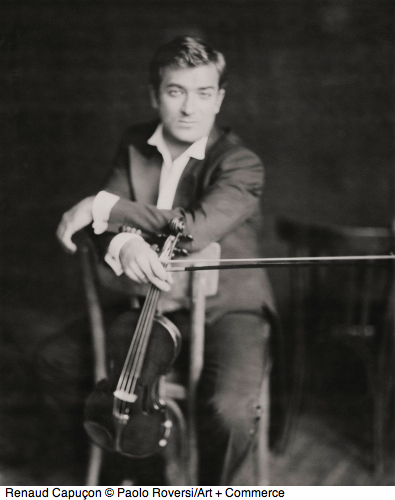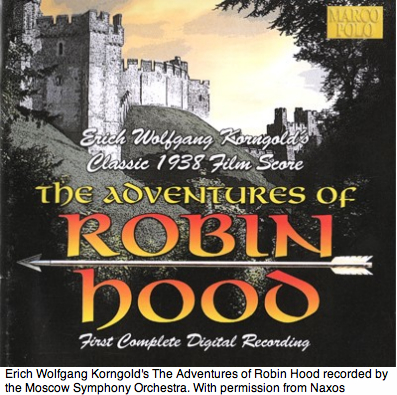This weekend as Disney Hall, the Violin Concerto of Erich Wolfgang Korngold will be played by French heartthrob Renaud Capuçon and conducted by Manchester United-fan Daniel Harding. After halftime for Mahler's Fifth Symphony, the symphony with the beautiful, slow music from Death in Venice.
Renaud talked to me about Korngold's concerto earlier this week, and why it makes so much sense in L.A.
LV: Do you like playing Korngold in Disney Hall?
Renaud Capuçon: I love it, it's a great hall; and I love to play it in L.A., because it was premiered here with the L.A. Phil and Jascha Heifetz -- and I've played it in Paris with Gustavo conducting!
LV: Korngold wrote a lot of great Hollywood film music, like Captain Blood and The Adventures of Robin Hood. Does the "Violin Concerto" sound like film music?
Renaud Capuçon: He was absolutely not a Hollywood composer. He was a Viennese, a central European composer, and the "Violin Concerto" is Korngold from Europe mixed with Korngold of the cinema. It's not film music.
LV: What's it like to play the same music with different conductors?
Renaud Capuçon: It's a magical thing when you change conductors. You listen and talk to the conductor, like in chamber music. Of course, I still have my own ideas and my own sound, but it can change in the collaborative process. Even when I tour with the same conductor, the result will be different because of the different halls, or the audience or, sometimes, just a mood.
For a conductor to be able to balance their own ideas of the performance's dynamic range and speed with me in real time -- while the performance is actually going on -- requires that the conductor knows how I use my violin and bow as intimately as that conductor would know how a singer uses their voice. In each, the inevitable, continual adjustments make a performance unique -- not only for the audience, but for the musicians, as well, who are equally curious to see what the results will be.
LV: Do you like to play around with different instruments and bows?
Renaud Capuçon: I loved the violin straightaway, and have played it from the time I was five. It was the sound that got me, and I just kept on looking for more sound -- which meant trying as many violins as I could, because each one sounded different. When I discovered that bows could also change the sound -- well, now I've become a bit crazy about bows. Right now, I have a beautiful Tourte which is so wonderful that I use it all the time, although I am tempted to use a different one for big demanding pieces like Bartok's #2 or Shostakovich's #1.
LV: I'm starting Suzuki with my granddaughter. How hard is the Korngold to play?
Renaud Capuçon: You'll have to wait until you can play the Brahms or Tchaikovsky violin concertos. And then, if you want to play it really well, you must try to guess what Korngold -- what any composer -- wanted to say. Just playing the notes is not the goal; serving the music is.
Violin Concerto
Erich Wolfgang Korngold
Composed: 1937-1939, revised 1945
Length: 25 minutes
Orchestration: 2 flutes (2nd = piccolo), 2 oboes (2nd = English horn), 2 clarinets, bass clarinet, 2 bassoons (2nd = contrabassoon), 4 horns, 2 trumpets, trombone, timpani, percussion (bass drum, cymbals, gong, vibraphone, xylophone, bells, chimes), harp, celesta and strings.
First Los Angeles Philharmonic performance: January 8, 1953, Alfred Wallenstein conducting, with soloist Jascha Heifetz.
Read Hugh Macdonald's liner notes here.
Our 2024 Coverage Needs You
It's Another Trump-Biden Showdown — And We Need Your Help
The Future Of Democracy Is At Stake
Our 2024 Coverage Needs You
Your Loyalty Means The World To Us
As Americans head to the polls in 2024, the very future of our country is at stake. At HuffPost, we believe that a free press is critical to creating well-informed voters. That's why our journalism is free for everyone, even though other newsrooms retreat behind expensive paywalls.
Our journalists will continue to cover the twists and turns during this historic presidential election. With your help, we'll bring you hard-hitting investigations, well-researched analysis and timely takes you can't find elsewhere. Reporting in this current political climate is a responsibility we do not take lightly, and we thank you for your support.
Contribute as little as $2 to keep our news free for all.
Can't afford to donate? Support HuffPost by creating a free account and log in while you read.
The 2024 election is heating up, and women's rights, health care, voting rights, and the very future of democracy are all at stake. Donald Trump will face Joe Biden in the most consequential vote of our time. And HuffPost will be there, covering every twist and turn. America's future hangs in the balance. Would you consider contributing to support our journalism and keep it free for all during this critical season?
HuffPost believes news should be accessible to everyone, regardless of their ability to pay for it. We rely on readers like you to help fund our work. Any contribution you can make — even as little as $2 — goes directly toward supporting the impactful journalism that we will continue to produce this year. Thank you for being part of our story.
Can't afford to donate? Support HuffPost by creating a free account and log in while you read.
It's official: Donald Trump will face Joe Biden this fall in the presidential election. As we face the most consequential presidential election of our time, HuffPost is committed to bringing you up-to-date, accurate news about the 2024 race. While other outlets have retreated behind paywalls, you can trust our news will stay free.
But we can't do it without your help. Reader funding is one of the key ways we support our newsroom. Would you consider making a donation to help fund our news during this critical time? Your contributions are vital to supporting a free press.
Contribute as little as $2 to keep our journalism free and accessible to all.
Can't afford to donate? Support HuffPost by creating a free account and log in while you read.
As Americans head to the polls in 2024, the very future of our country is at stake. At HuffPost, we believe that a free press is critical to creating well-informed voters. That's why our journalism is free for everyone, even though other newsrooms retreat behind expensive paywalls.
Our journalists will continue to cover the twists and turns during this historic presidential election. With your help, we'll bring you hard-hitting investigations, well-researched analysis and timely takes you can't find elsewhere. Reporting in this current political climate is a responsibility we do not take lightly, and we thank you for your support.
Contribute as little as $2 to keep our news free for all.
Can't afford to donate? Support HuffPost by creating a free account and log in while you read.
Dear HuffPost Reader
Thank you for your past contribution to HuffPost. We are sincerely grateful for readers like you who help us ensure that we can keep our journalism free for everyone.
The stakes are high this year, and our 2024 coverage could use continued support. Would you consider becoming a regular HuffPost contributor?
Dear HuffPost Reader
Thank you for your past contribution to HuffPost. We are sincerely grateful for readers like you who help us ensure that we can keep our journalism free for everyone.
The stakes are high this year, and our 2024 coverage could use continued support. If circumstances have changed since you last contributed, we hope you'll consider contributing to HuffPost once more.
Already contributed? Log in to hide these messages.


